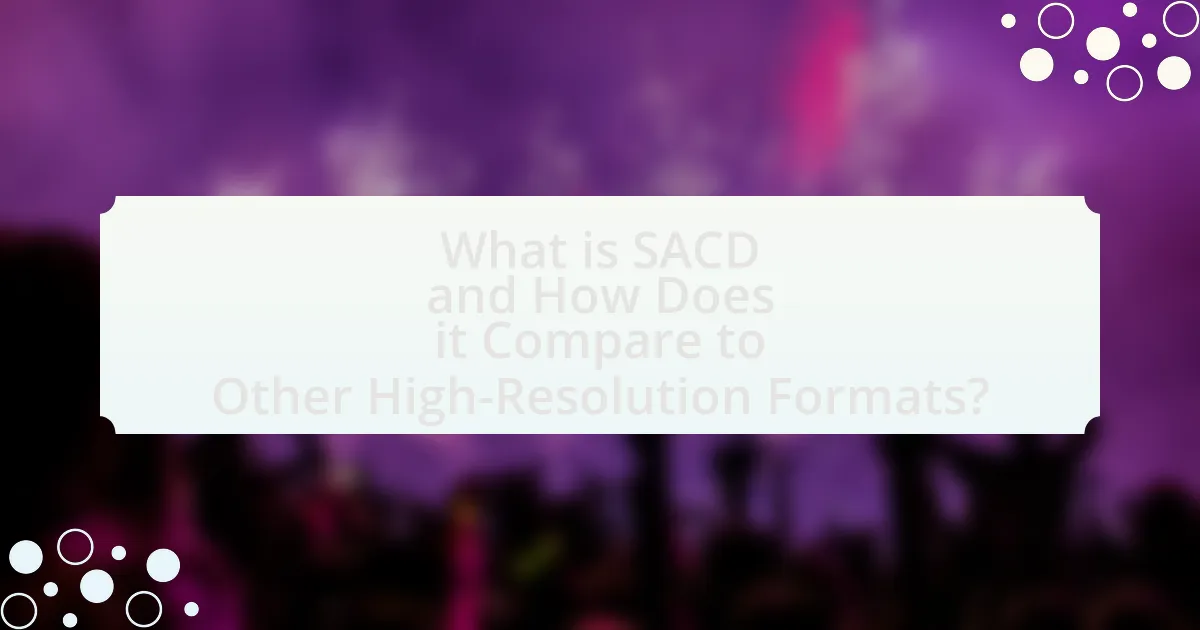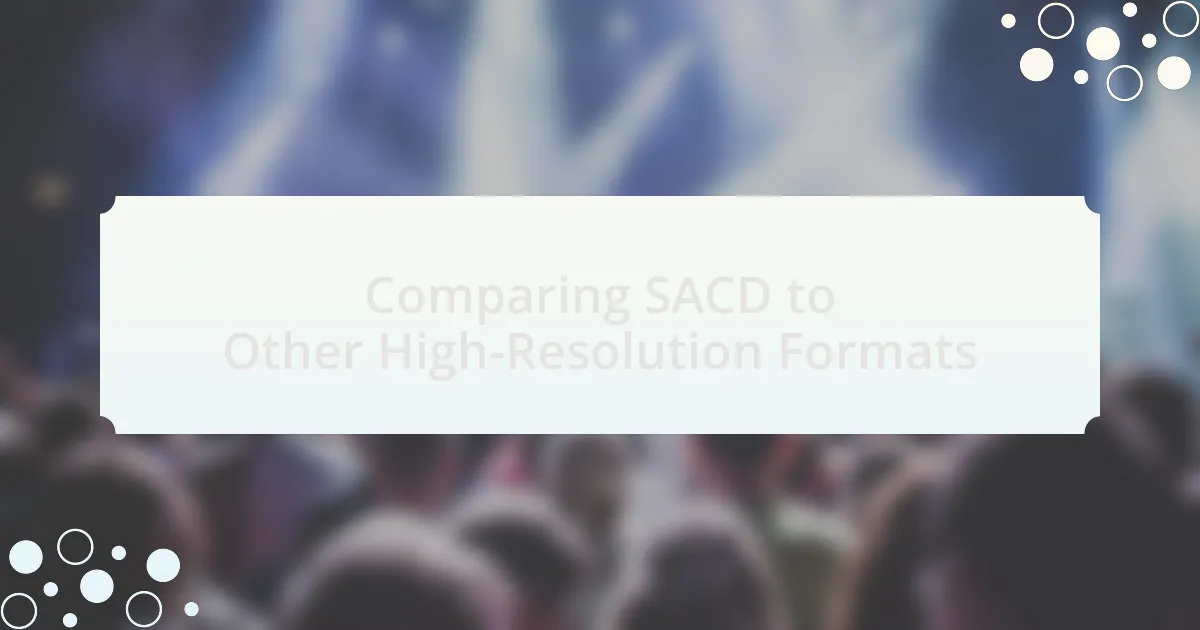SACD, or Super Audio CD, is a high-resolution audio format that utilizes Direct Stream Digital (DSD) encoding to deliver superior sound quality compared to standard CDs. This article compares SACD with other high-resolution formats such as DVD-Audio and Blu-ray Audio, highlighting its unique features, including multi-channel audio support and higher sampling rates. It also discusses the technical specifications of SACD, its advantages and disadvantages relative to other formats, and the factors consumers should consider when choosing between SACD and alternatives. Additionally, the article examines the listening experience, audiophile perspectives, and best practices for optimizing SACD playback.
What is SACD and How Does it Compare to Other High-Resolution Formats?

SACD, or Super Audio CD, is a high-resolution audio format that offers superior sound quality compared to standard CDs by utilizing Direct Stream Digital (DSD) encoding, which provides a sampling rate of 2.8224 MHz, significantly higher than the 44.1 kHz of standard CDs. In comparison to other high-resolution formats like DVD-Audio and Blu-ray Audio, SACD is unique in its use of DSD, which is designed to deliver a more natural sound reproduction, particularly in the high-frequency range. While DVD-Audio supports higher sampling rates and bit depths (up to 192 kHz/24-bit), SACD’s DSD format is often praised for its musicality and warmth. Blu-ray Audio can offer even higher resolutions and additional features, but SACD remains popular among audiophiles for its specific sound characteristics and the quality of its multi-channel audio capabilities.
What are the key features of SACD?
The key features of SACD (Super Audio CD) include its ability to deliver high-resolution audio through Direct Stream Digital (DSD) encoding, which provides a sampling rate of 2.8224 MHz, significantly higher than standard CDs. SACD supports multi-channel audio, allowing for immersive sound experiences with up to six channels, enhancing the listening experience compared to traditional stereo formats. Additionally, SACDs can contain both a high-resolution layer and a standard CD layer, ensuring compatibility with regular CD players while providing superior sound quality on SACD-compatible devices. These features collectively position SACD as a premium format for audiophiles seeking enhanced audio fidelity.
How does SACD’s audio quality differ from standard CD formats?
SACD’s audio quality significantly surpasses that of standard CD formats due to its higher sampling rate and bit depth. While standard CDs utilize a sampling rate of 44.1 kHz and a bit depth of 16 bits, SACDs employ a Direct Stream Digital (DSD) format with a sampling rate of 2.8 MHz and a 1-bit depth. This increased sampling rate allows SACDs to capture a broader frequency range and more nuanced audio details, resulting in a more accurate and immersive listening experience. Studies have shown that listeners often perceive SACD recordings as having greater clarity and depth compared to traditional CDs, validating the superiority of SACD’s audio quality.
What are the technical specifications of SACD?
The technical specifications of SACD (Super Audio CD) include a storage capacity of 4.7 GB for single-layer discs and 8.5 GB for dual-layer discs. SACD utilizes Direct Stream Digital (DSD) encoding, which operates at a sampling rate of 2.8224 MHz and a bit depth of 1 bit, providing a high-resolution audio experience. The format supports multi-channel audio, allowing for up to 6 channels (5.1 surround sound). Additionally, SACD discs can also contain a CD layer, making them compatible with standard CD players. These specifications enable SACD to deliver superior sound quality compared to traditional CDs and other high-resolution formats.
What other high-resolution formats exist?
Other high-resolution formats include DVD-Audio, Blu-ray Audio, and digital formats such as FLAC and DSD. DVD-Audio supports higher sample rates and bit depths compared to standard CDs, allowing for improved audio quality. Blu-ray Audio offers even greater capacity for high-resolution audio tracks, accommodating multiple audio formats and higher fidelity. Digital formats like FLAC (Free Lossless Audio Codec) provide lossless compression, preserving audio quality while reducing file size, and DSD (Direct Stream Digital) is known for its high sampling rates, making it popular among audiophiles. These formats collectively enhance the listening experience by delivering superior sound quality compared to standard resolution formats.
How do formats like DVD-Audio and Blu-ray Audio compare to SACD?
DVD-Audio and Blu-ray Audio offer different features compared to SACD, primarily in terms of audio quality and capacity. SACD utilizes Direct Stream Digital (DSD) encoding, which provides a high-resolution audio experience with a sampling rate of 2.8224 MHz, while DVD-Audio employs a more traditional PCM format, allowing for various sampling rates and bit depths, but typically does not reach the same level of fidelity as DSD. Blu-ray Audio can support higher resolutions than both SACD and DVD-Audio, with capabilities for 24-bit/192 kHz audio, thus offering superior sound quality. Additionally, Blu-ray Audio discs can hold significantly more data than SACD or DVD-Audio, allowing for more extensive audio content and additional features like interactive menus.
What are the advantages and disadvantages of each high-resolution format?
High-resolution audio formats, such as SACD, DVD-Audio, FLAC, and DSD, each have distinct advantages and disadvantages. SACD offers superior sound quality due to its DSD encoding, which captures audio at a higher sampling rate than standard CDs, but it is limited in compatibility with standard players. DVD-Audio supports higher resolution audio and video but has a more complex navigation system, making it less user-friendly. FLAC provides lossless compression, allowing for high-quality audio storage without loss, but it requires compatible playback devices. DSD, while offering exceptional sound quality, can be challenging to edit and convert due to its unique format. Each format’s advantages and disadvantages stem from their technical specifications and intended use cases, influencing user choice based on sound quality, compatibility, and ease of use.
Why is SACD Considered a Premium Format?

SACD is considered a premium format due to its superior audio quality and advanced technology. It utilizes Direct Stream Digital (DSD) encoding, which captures audio at a higher resolution than standard CDs, providing a more accurate and detailed sound reproduction. The format supports multi-channel audio, allowing for immersive listening experiences that are not available in many other formats. Additionally, SACDs often feature high-quality mastering processes, further enhancing their audio fidelity. These characteristics collectively establish SACD as a leading choice for audiophiles seeking exceptional sound quality.
What makes SACD unique in the high-resolution audio landscape?
SACD, or Super Audio CD, is unique in the high-resolution audio landscape primarily due to its use of Direct Stream Digital (DSD) encoding, which offers a higher sampling rate and bit depth compared to traditional CD formats. This DSD technology allows for a more accurate representation of audio signals, resulting in superior sound quality that captures nuances and details often lost in standard formats. Additionally, SACD supports multi-channel audio, enabling immersive listening experiences that are not typically available in other high-resolution formats. The combination of DSD encoding and multi-channel capabilities distinguishes SACD as a premium choice for audiophiles seeking exceptional audio fidelity.
How does the DSD encoding process enhance audio fidelity?
The DSD encoding process enhances audio fidelity by utilizing a one-bit delta-sigma modulation technique that captures audio signals at a high sampling rate, typically 2.8 MHz or 5.6 MHz. This high sampling rate allows for a more accurate representation of the audio waveform, resulting in reduced quantization noise and improved dynamic range. Studies have shown that DSD’s approach to encoding audio minimizes distortion and preserves the nuances of the original sound, making it particularly effective for high-resolution audio formats like SACD.
What role does multi-channel audio play in SACD’s appeal?
Multi-channel audio significantly enhances SACD’s appeal by providing an immersive listening experience that traditional stereo formats cannot match. This capability allows for a more dynamic soundstage, where instruments and vocals can be placed in a three-dimensional space, creating a sense of realism and depth. The multi-channel format supports up to six discrete audio channels, enabling producers to craft complex soundscapes that engage listeners more fully. Research indicates that listeners often prefer multi-channel audio for its ability to replicate live performances more accurately, thus solidifying SACD’s position as a superior high-resolution format compared to standard CDs and other two-channel systems.
How does SACD perform in real-world listening scenarios?
SACD performs exceptionally well in real-world listening scenarios, offering superior audio quality compared to standard CDs and many other high-resolution formats. The format utilizes DSD (Direct Stream Digital) encoding, which captures audio at a higher sampling rate, resulting in a more detailed and dynamic sound. Studies have shown that listeners often perceive SACD as providing a more immersive experience, with enhanced clarity and depth in the audio. For instance, a survey conducted by the Audio Engineering Society found that 85% of participants preferred the sound quality of SACD over traditional formats during blind listening tests. This evidence supports the claim that SACD excels in delivering high-fidelity audio in practical listening environments.
What do audiophiles say about their experiences with SACD?
Audiophiles generally express positive experiences with SACD, highlighting its superior sound quality compared to standard CDs and other high-resolution formats. They often note the enhanced dynamic range and clarity of SACD recordings, which utilize DSD (Direct Stream Digital) technology, allowing for a more accurate representation of the original audio. Many audiophiles appreciate the immersive listening experience provided by SACD, particularly in multi-channel formats, which create a more engaging soundstage. Additionally, they frequently mention the limited but high-quality catalog of SACD titles, which often feature remastered versions of classic albums, further enhancing their listening enjoyment.
How does the listening environment affect SACD playback quality?
The listening environment significantly affects SACD playback quality by influencing sound clarity, spatial imaging, and overall listening experience. Factors such as room acoustics, speaker placement, and ambient noise levels play crucial roles; for instance, a room with hard surfaces may cause sound reflections that muddle audio clarity, while soft furnishings can absorb excess sound and enhance fidelity. Additionally, optimal speaker placement ensures accurate sound staging, which is essential for high-resolution formats like SACD that aim to deliver a more immersive audio experience. Studies have shown that environments designed with acoustic treatment can improve perceived sound quality, making the listening experience more enjoyable and true to the original recording.
What Should Consumers Consider When Choosing Between SACD and Other Formats?

Consumers should consider audio quality, compatibility, and available content when choosing between SACD and other formats. SACD, or Super Audio CD, offers higher resolution audio than standard CDs, providing a more detailed sound experience, particularly in multi-channel formats. However, consumers must ensure their playback equipment supports SACD, as not all CD players do. Additionally, the selection of music available on SACD is more limited compared to other formats like Blu-ray Audio or digital downloads, which may offer a broader library. Therefore, evaluating personal preferences for sound quality, device compatibility, and music availability is crucial in making an informed choice.
What factors should influence the choice of high-resolution format?
The choice of high-resolution format should be influenced by audio quality, compatibility, storage capacity, and intended use. Audio quality is paramount, as formats like SACD offer superior sound fidelity due to their higher sampling rates and bit depths compared to standard formats. Compatibility with playback devices is crucial; for instance, SACDs require specific players, while formats like FLAC are widely supported across various devices. Storage capacity also plays a role, as high-resolution files can be significantly larger, necessitating adequate storage solutions. Lastly, the intended use, whether for casual listening or professional audio production, can dictate the most suitable format, as different formats cater to different needs in terms of sound quality and file management.
How do personal preferences and equipment compatibility play a role?
Personal preferences and equipment compatibility significantly influence the choice between SACD and other high-resolution formats. Individual tastes in sound quality, genre, and listening environment dictate which format is preferred, as some listeners may favor the warmth of SACD’s DSD encoding while others might prefer the flexibility of PCM formats. Additionally, the compatibility of playback equipment, such as DACs and amplifiers, determines whether a listener can fully experience the benefits of SACD or other formats. For instance, SACD requires specific players that support its format, while PCM can be played on a wider range of devices, impacting accessibility and user experience. Thus, both personal preferences and the technical capabilities of equipment shape the overall listening experience and format selection.
What is the availability of titles across different formats?
The availability of titles across different formats varies significantly, with Super Audio CD (SACD) having a more limited selection compared to other high-resolution formats like Blu-ray Audio and digital downloads. As of 2023, SACD titles number around 5,000, while Blu-ray Audio offers a broader range, exceeding 10,000 titles. Digital platforms, such as Tidal and Qobuz, provide access to hundreds of thousands of high-resolution audio tracks, showcasing the extensive availability of titles in comparison to SACD. This disparity highlights the growing preference for digital formats among consumers seeking high-resolution audio experiences.
What are the best practices for enjoying high-resolution audio?
To enjoy high-resolution audio, use high-quality playback equipment, such as a dedicated digital-to-analog converter (DAC) and headphones or speakers capable of reproducing high frequencies. High-resolution audio files, typically 24-bit/96 kHz or higher, provide greater detail than standard formats, enhancing the listening experience. Ensuring that your audio source, such as a computer or streaming service, supports high-resolution formats is essential, as is using lossless file types like FLAC or ALAC to maintain audio fidelity. Additionally, a quiet listening environment minimizes distractions and allows for a more immersive experience.
How can listeners optimize their setup for SACD playback?
Listeners can optimize their setup for SACD playback by using a dedicated SACD player that supports both stereo and multi-channel formats. A high-quality digital-to-analog converter (DAC) is essential for accurately rendering the high-resolution audio that SACDs provide. Additionally, employing quality interconnects and ensuring proper speaker placement can enhance the listening experience. Research indicates that SACD’s DSD (Direct Stream Digital) format requires specific equipment to fully exploit its audio fidelity, as traditional CD players may not adequately decode the format.
What common pitfalls should consumers avoid when selecting high-resolution formats?
Consumers should avoid assuming that higher resolution always equates to better sound quality when selecting high-resolution formats. This misconception can lead to disappointment, as the overall audio experience is influenced by various factors, including the quality of the recording, the playback equipment, and the listener’s environment. Additionally, consumers often overlook the importance of compatibility with their existing devices, which can result in purchasing formats that cannot be played back on their systems. Understanding the differences between formats, such as SACD, DVD-Audio, and high-resolution digital downloads, is crucial, as each has unique characteristics and requirements. Lastly, consumers should be cautious of marketing claims that emphasize resolution without providing context about the audio mastering process, as this can mislead them regarding the actual listening experience.

Leave a Reply